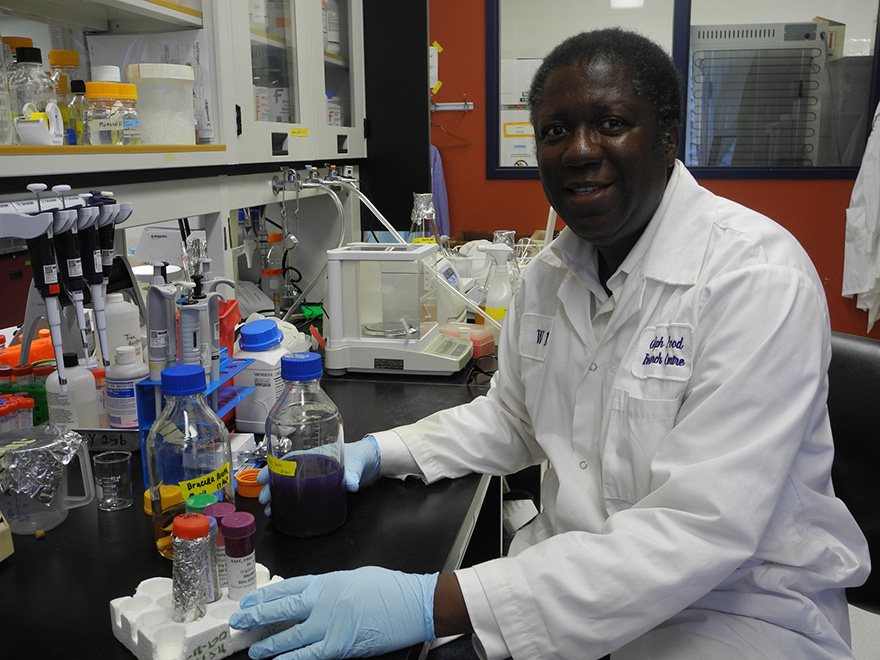Research into antimicrobial resistance funded through the Government of Canada's Genomics Research and Development Initiative (GRDI) suggests it may be possible to eliminate the preventive use of antibiotics in Canada's poultry industry.
"Salmonella bacteria is fairly common in poultry, and can be passed to humans through improper handling of raw chicken or eating chicken that is not thoroughly cooked. If a person is infected with one of these fosfomycin‑resistant strains, the infection—which can be very serious—will be more difficult to treat."
The study, led by Agriculture and Agri‑Food Canada Research Scientist Dr. Moussa Diarra, is one of close to two dozen closely interlocked research projects underway at 5 different federal departments and agencies—all supported by the GRDI as part of a major, 5‑year research collaboration using genomics to better understand how antibiotics used in food production may impact on antimicrobial resistance (AMR) in humans.
The risk is real

Dr. Moussa Diarra in his lab at AAFC's Guelph Research and Development Centre (photo: AAFC)
The study led by Dr. Diarra has already revealed that some strains of the Salmonella bacteria found in chickens—and which can infect humans—carry a previously unknown gene which gives the bacteria a high degree of resistance to fosfomycin, an important antibiotic used to treat infections in both animals and people.
"This is definitely a concern," says Dr. Diarra, "Salmonella bacteria is fairly common in poultry, and can be passed to humans through improper handling of raw chicken or eating chicken that is not thoroughly cooked. If a person is infected with one of these fosfomycin‑resistant strains, the infection—which can be very serious—will be more difficult to treat."
Collaboration essential to tracking AMR
Dr. Diarra says these kinds of findings make the interdepartmental collaboration enabled by the GRDI‑AMR project a key to understanding how AMR can be transmitted. "This collaboration means we have access to the genetic data of bacterial isolates not just from poultry, but to those collected from people, other areas of food production and the environment," says Dr. Diarra. "We can compare and analyse the AMR genes from all these isolates, and begin to understand how and where they may be connected in terms of transmitting from one area to another—and how we might reduce the risk of that happening."
Industry already reducing use of antibiotics
"An antibiotic is just one molecule, so it's easier for bacteria to develop resistance to the drug…berry compounds are more complex, so it's more difficult for bacteria to develop resistance—plus, they also strengthen the immune system as a whole, so the chicken is better able to fight infection in the first place."
Dr. Diarra notes that due to concerns over AMR, the Canadian poultry industry has recently largely eliminated what had been the routine practice of giving chickens a range of antibiotics in their feed in order to prevent infections. It plans to stop the preventive use of all but the least important antibiotics by the end of 2020—making the development of alternatives a priority. "As important as it is to addressing the larger issue of AMR, the development of alternatives to antibiotics as a way of preventing infection is an important economic consideration for the industry," says Dr. Diarra. "In a large poultry operation, identifying and treating one or two sick birds before the entire flock is infected is simply not practical—maybe not even possible."
Alternatives to antibiotics showing promise

Extracts from cranberries are showing promise as a way to reduce the use of antibiotics in the poultry industry. (photo: AAFC)
In fact, in addition to seeking out how AMR may be transmitted from poultry to humans, Dr. Diarra's team is also applying genomics to study the effectiveness of non‑antimicrobial substances in preventing and treating infection. "Compounds derived from cranberries, for example, are already being used in controlling urinary tract infections in people," says Dr. Diarra. "We're looking at those, as well as blueberries and others as potential alternatives."
Dr. Diarra says compounds derived from berries work differently than antibiotics, so AMR is less of a concern. "An antibiotic is just one molecule, so it's easier for bacteria to develop resistance to the drug," explains Dr. Diarra. "These berry compounds are more complex, so it's more difficult for bacteria to develop resistance—plus, they also strengthen the immune system as a whole, so the chicken is better able to fight infection in the first place."
Welcome news
At the Chicken Farmers of Canada, Director of Food Safety and Animal Health Steve Leech says research like that being carried on by Dr. Diarra under the GRDI is crucial to the sustainability of Canada's multibillion‑dollar poultry industry. "This kind of fundamental research into understanding how AMR can be transmitted and developing strategies to address that—from management practices to vaccines to effective alternatives to antibiotics—is a priority for our organization. It's essential to meeting our objectives as an industry, as well as the objectives set out in the Pan‑Canadian Framework for Action on AMR," says Mr. Leech.